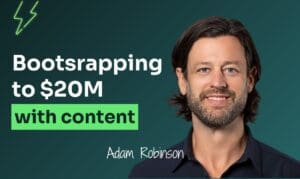Are You Distributing Content Wrong?
In conversation with Joshua Shulman.
There’s a lot of buzz around content. Who creates what, how, when. Gated vs ungated, backlinking, SEO, and everything in between.
And yet somehow, we skip out on the distribution side of things. We assume that when we create the disruptive, closing the loop, paradigm shift-creating content, everyone in our audience will see it.
We aren’t shitting on the ways people produce and position their content. Yet.
This is about how distribution fits into content strategy and how we can distribute content better.
Shoutout to Ross Simmonds from Foundation Inc. His framework around the principle, “create once, distribute forever” is all about leveraging as many channels as you have at your disposal. We’ve taken the liberty to look at a few of his concepts here.
Ross’s framework is a great one, but it’s missing a few key points. Ross talks about all social media channels and what sort of content works on each one. But he leaves out email marketing metrics, paid media channels (that you probably haven’t heard of if you aren’t in a specific niche) and legacy channels (print, in-person, etc).
If you’re focusing only on PPC, paid social, organic social and maybe even email marketing, you’re missing out. Big time.
So, how do you go about distribution in a more holistic way? Let’s dive in.
Legacy channels:
How do legacy channels translate to high-value B2B sales?
For one, you could go to tradeshows and present data. Sounds way too simplistic.
But wait, hear us out.
Josh talked about how Bitmovin went to multiple trade shows and presented a ‘video developer report’ every single year. This report was based on an extensive survey they do of video developers from all around the world.
This report isn’t just a data sheet with a few numbers and graphs. It’s a full-blown, perfectly-designed digital asset.
In Josh’s words, “it’s not something that is measured, it’s something that is remembered.”
When people are handed those reports, they often end up tweeting about it. It stays up on their social media wall, unprompted. That’s free marketing. Ad space without having to buy any.
Second, direct mail.
If you have a high ACV prospect, and you have their details (without coming across as creepy or violating the GDPR guidelines), sending them a personalized gift may not be a bad idea after all. Ofcourse, it can’t be something outrageous like a photo frame with them and their mom from a photo you found on FB. A swag box or an embossed t-shirt is more like it.
Oh of course, don’t forget to slip in a shameless plug about your product.
What about Email?
Ehh, technically Email doesn’t count as a legacy channel, because for one, it’s still around. But while it is a 90’s thing, they work. And it works well.
So, to no one’s surprise, everyone’s doing email newsletters. Probably even your accountant. (Okay, maybe not.)
But, getting newsletters, being excited about them and reading all of them was a thing in the early 2000s. Now, your prospects spend less than 11 seconds on your email. If they open it at all, that is.
Partly because somewhere in the early 2010’s, email newsletters became spammy and salesy. Eventually, marketers repackaged it to something entirely different (read: painstakingly similar) and sent it to their audience. This worked for a bit up until email newsletters made a comeback.
Morning brew was one of the drivers. Instead of pushing for their product, they pushed information on email. The referral system worked out really well for them too. Ofcourse, this requires you to have the right content in place first.
The key takeaway here: Get on board with email newsletters and try them out. Even in 2022, email newsletters are worth it. Back in the day, they were teasers to the content on your website. Now, they’re sometimes a mile and a half long with a lot of value. And yes, people read ‘em.
Does day and time matter?
At Klear, we have better open rates on Fridays. And ideally, we try to send them before 2 pm CET. Maybe it’s because people dedicate more time to learning on a Friday or maybe they just want to clear up their email before the week ends. Saturdays and Sundays are usually bad times for us. See what works for you, experiment with when you send them out. Play around with what gets you the best results.
Dark social
Chris Walker coined the phrase ‘dark social’. It refers to the channels people go to to get professional information. But these channels aren’t tracked by attribution or analytics software. Think LI or a closed community on Slack.
For example: say someone were to talk about you and link to your website on one of these channels, let’s say an invite-only Slack community. If and when people clicked on it and checked you out, you wouldn’t know because your software doesn’t track it.
Data-driven marketers usually want nothing to do with this. Mainly because not knowing if it works is as good as knowing it doesn’t. But, Chris Walker suggests that is where the real shiz happens.
So, how do you go about distributing content in these channels?
- Make content snackable: Basically, give away value in snippets instead of long drawn out answers. But, don’t cut it short for the heck of it. No teasers, no BS. Pure value. Quotes that can be put in a video, gif or even an image work.
- Don’t spam: If this is too obvious for you, go ahead and think why so many “influencers” post every single day while creating net 0 value. Be it LI or a slack community, engaging is one thing, sending out multiple messages a day and driving people mad is another.
- Help people: Dark socials are communities. In a community, you help one another. Start by engaging with people who have questions. Be helpful. And then, if and only if necessary, slip in one of your resources and ask them to check it out.
As long as you keep it helpful, non-salesy and organic, you’re doing fine.
“Other” paid channels
Other channels include channels that niche industries already know of, but a lot of people outside those industries don’t. Leveraging the channel to meet your goals depends on how well you know your industry and if certain publications that exist in those industries are willing to publish your content.
Magazines that were once print-only are now going digital. If these publications have access to your audience, you being featured in them is one of the best ways to create the first touchpoint. This is usually transactional, you give them content to put on their newsletter, and they give you reach.
Conclusively, using 10 channels instead of 3 isn’t going to make your content distribution strategy better. If anything, it’s going to overwhelm you and your audience. Focus on the ones you have resources for. Test a few, and then scale.
Scaling through the number of channels isn’t your only alternative. If something sticks, just multiply it. For example, if a partnership with a publication brings you multiple leads, you don’t have to add on engaging in a slack community to the list, maybe consider partnering with multiple publications. Ultimately, the goal isn’t to generate leads, it’s to generate demand first.
Related Posts
- How to do agile account-based content marketing - ep 5
Agile? Account-based? Content marketing? That's a mouthful! It may look like buzzword-bonanza at first glance,…
- Klear ABM framework - ep 29
https://youtu.be/iRn0kTto360 Are you looking to scale marketing at your company?Let’s take a look at the…
- How to hire a B2B marketer - ep 22
Are you looking to hire a marketing star but don’t have a clear idea of…

